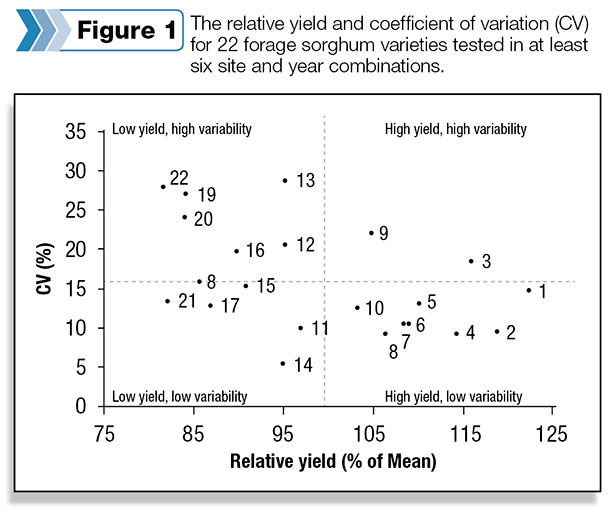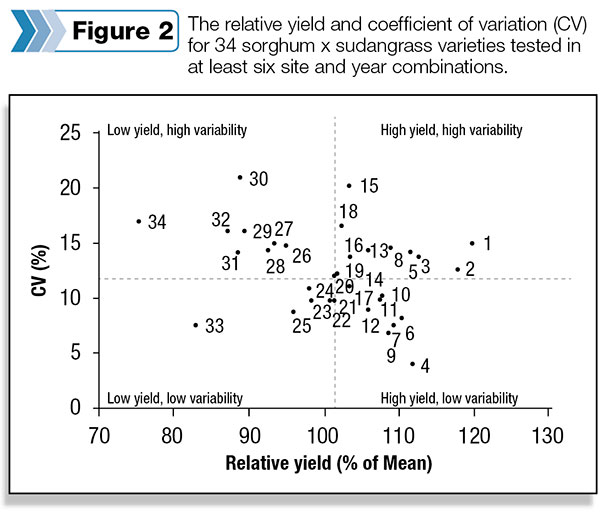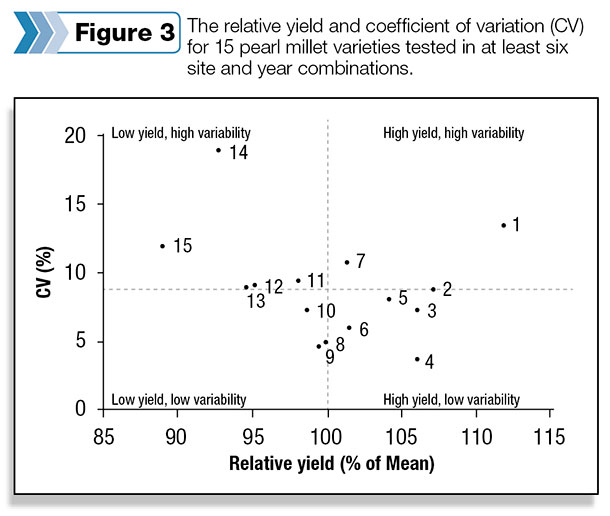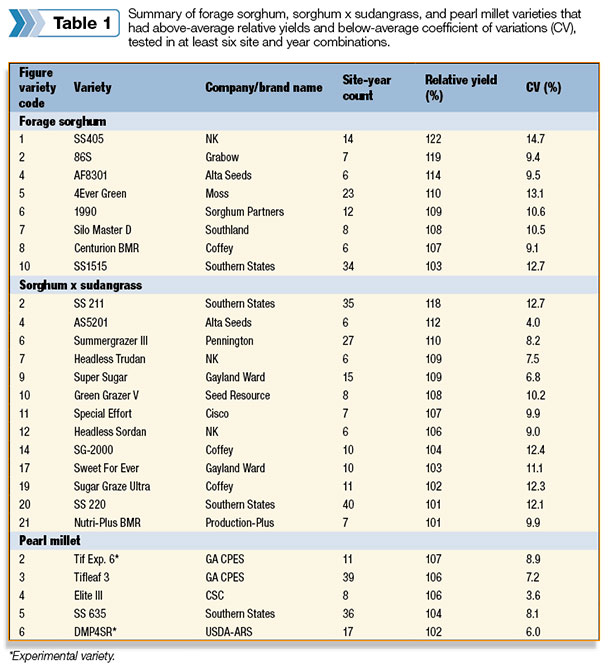Have you ever wondered which summer annual species and variety is best for your forage system? Often, varieties of forage sorghum, sorghum x sudangrass and pearl millet are chosen based on convenience and affordability, with less emphasis on quality and quantity.
Although good management is key to a successful summer annual forage program, it is important to understand that not all summer annual varieties perform equally. In addition, some varieties perform differently from year to year and location to location, while others are more stable.
Warm-season grass species are important forage crops due to their known forage quality, yield and drought resistance. They provide producers with a good forage option when temperatures in the summer exceed 80ºF or when cool-season species become unable to produce adequate amounts of tonnage and high-quality forage.
To fill the “summer slump,” producers often rely on warm-season perennial grasses such as native prairie grasses, bermudagrass or bahiagrass. However, in some situations, it is better to use summer annuals rather than perennials, especially when renovating perennial pastures or when higher-quality forage is desired.
Although there are several warm-season annuals on the market, forage sorghum, sorghum x sudangrass and pearl millet are among the most popular species.
Forage sorghum
Forage sorghums perform well when moisture is limited, can grow to a height of 8 to 13 feet tall and typically yield 4 to 8 dry tons per acre. Most varieties have the ability to produce a ratoon crop (regrowth) that may be grazed or used for multiple harvests. Depending on the variety, forage sorghums can contain 0 to 50 percent grain in the forage and are best suited for silage or baleage.
The thick stems of forage sorghum readily hold moisture. Combining this with the high tonnage, curing forage sorghum for hay is difficult and therefore not recommended, even with the use of a conditioner.
Sorghum x sudangrass
Sorghum x sudangrass is a hybrid cross between forage sorghum and sudangrass. Stems and leaves of the hybrid are generally taller and thicker than sudangrass and consequently produce larger yields. Plants grow to be 5 to 12 feet tall, and yields have been found to vary from 4 to 10 tons per acre, depending on management and environmental conditions.
The best use of sorghum x sudangrass is for grazing or for silage. Plants should not be grazed lower than 8 to 12 inches tall to ensure rapid and timely regrowth.
Typically, stems are too thick to be used for hay and may require an elongated period of drying. If using this species for hay, it is recommended that a roller or crimper-style conditioner be used to maximize drying.
Pearl millet
Pearl millet is a deep-rooted, drought-tolerant bunchgrass that grows 3 to 8 feet tall. In general, one can expect pearl millet to yield 4 to 6 tons per acre under good management conditions. Pearl millet is well suited for grazing but may also be used for silage and hay production.
It grows back rapidly and produces many tillers (several stems) at its base. Grazing can begin once the plant reaches a height of 20 to 24 inches, and the cutting or grazing height should not be lower than 4 to 6 inches to promote timely regrowth and reduce plant injury.
Challenges
Summer annuals do have their challenges. However, all of these challenges can be minimized or avoided with proper management. A common concern for using any member of the sorghum family is the risk of prussic acid poisoning. Prussic acid poisoning occurs when cyanide-forming compounds found naturally in the plant are released in response to extreme drought or frost injury.
Prussic acid poisoning is of greatest risk in young plants and the stressed tissues of older plants. Fortunately, prussic acid is volatile and will dissipate over time. Therefore, it is important to allow at least 10 days of rest before grazing after severe drought stress or a major frost event that damages green leaves.
Nitrate poisoning is another concern when cattle are provided summer annual forages. If periods of limited moisture or drought occur after fertilization with nitrogen, summer annuals will store that nitrogen as nitrates in their vegetative tissue until adequate moisture allows for growth.
Concentrations of nitrates are often highest in the stems and leaves closest to the ground. Unlike prussic acid, nitrates are stable in plant tissues, and high nitrate concentrations will persist in both hay and ensiled forages.
What is the right variety?
To better understand how summer annual varieties perform across multiple years and environments, forage yield data from multiple state and local variety test programs were collected. Summer annual forage yield data from 1998 to 2014 were collected from the University of Georgia, University of Kentucky, Virginia Tech and The Samuel Roberts Noble Foundation.
In total, there were 126 forage sorghum varieties, 200 sorghum x sudangrass varieties and 54 pearl millet varieties individually identified in the dataset.
To standardize across years and locations, yields were expressed as a percentage of the average within a given site and year. For example, if one variety had a yield of 5 dry tons per acre, and the average in that year and location among all the entries was 4 dry tons per acre, then the standardized relative yield was 125 percent (5 ÷ 4 = 1.25 x 100 = 125 percent).
A relative yield of 100 percent was average, and anything above 100 percent was considered to be above average and desirable.
The analysis then excluded varieties that had been evaluated in fewer than six site-year combinations. For each of the remaining varieties (22 forage sorghum, 34 sorghum x sudangrass and 15 pearl millet), we averaged across the relative yields for each available site-year combination for that given variety.
We also calculated a coefficient of variation (CV) for those varieties included in the analysis. The CV is calculated as the standard deviation (a measure of variability) of the relative yields divided by the average of the relative yields and expressing this as a percentage of the average.
As such, the CV is a helpful statistic because it gives a picture of how consistent a variety performed across multiple years and locations. For example, a variety that has a CV of 20 percent is twice as variable as a variety that has a CV of 10 percent. As a rule of thumb, a CV of less than 10 percent is considered ideal.
The average relative yield and CV for each species were calculated, and this enabled the varieties to be separated into quadrants (Figures 1, 2 and 3) of high relative yield and low variability (bottom right quadrant), high relative yield and high variability (top right quadrant), low relative yield and low variability (bottom left quadrant), and low relative yield and high variability (top right quadrant).

In each species, varieties that fell in the bottom right quadrant are considered most desirable because they consistently performed above average across multiple years and varying environmental conditions.

In contrast, varieties that fell in the top left quadrant are considered least desirable to use in a summer annual forage production system due to their decreased performance and variability between years and across multiple environments.

A list of the varieties that consistently exhibited above-average yields (i.e., high relative yield) and below-average variability (i.e., below-average CV) is indicated by species in Table 1. The full results of the comparison can be found online at Variety Selection of Warm Season Annual Grasses.

There are many varieties of summer annual forages available; however, not all varieties perform equally. When selecting a variety of forage sorghum, sorghum x sudangrass or pearl millet, compare the performance results provided by local and national forage variety testing programs before choosing a variety to use in your forage system. FG
Dennis W. Hancock is an associate professor and state forage extension specialist with the University of Georgia Department of Crop and Soil Sciences.
The authors would like to thank John Gassett and the University of Georgia’s statewide variety testing program, Dr. Ray Smith and the University of Kentucky’s forage variety trial program, Dr. Chris Teutsch and Virginia Tech’s Southern Piedmont trials, and Jim Johnson, Shawn Norton, Julie Barrick and the Samuel Roberts Noble Foundation for allowing them to use data from their research.
Deidre Harmon is agraduate student from the University of Georgia. Email Deidre Harmon.









